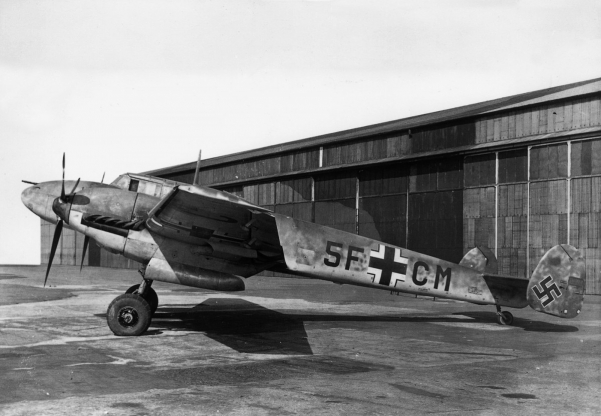
During the 1930s air strategists believed twin-engine “heavy fighters” to be essential to offensive air operations. As was happening elsewhere at the same time, in 1934 the Reichsluftfahrtministerium issued a requirement for a machine capable of tackling aircraft, including single-seat fighters, sent up to intercept the bombers; it was to make up in firepower what it lacked in manoeuvrability and was dubbed Zerstörer (destroyer). Messerschmitt’s prototype Bf 110V1 first flew in May 1936 and the production Bf 110 entered service as the Bf 110B with two 700hp (522kW) Junkers Jumo 210 engines. Only 45 were built before the advent of the Bf 110C with two Daimler-Benz DB 601 engines, which had seven sub-variants, and the Bf 110D, built in three.
Pitched against smaller, lighter fighter aircraft during the Battle of Britain, the Bf 110 proved vulnerable and from autumn 1940 production of the indifferent Bf 110C/D was scaled down. In spring 1941 two new variants, the -E (light bomber) and -F, appeared. The Bf 110F was introduced to take advantage of the powerful new DB 601F engine, and as the F-4 night-fighter got early Lichtenstein radar equipment. With later night versions -G and -H, in 1944 the Bf 110 represented 60 per cent of the strength of the Luftwaffe night-fighter units. By March 1945 a total of 6050 Bf 110s had been built.
Specifications
- Manufacturer
- Messerschmitt A.G
- Type
- Heavy Fighter
- Length
- 12.10m (39ft 8.33in)
- Span
- 16.20m (53ft 1.8in)
- Height
- 4.13m (13ft 6.5in)
- Maximum Speed
- 560km/h (248mph)
- Service Ceiling
- 10,000m (32,810ft)
- Range
- 1095km (680 miles)
- Crew
- 2/3
- Powerplant
- 2 x DB 601A-1
- Armament
- 1 x cannon, 5 x MG
- Bomb Load
- Not Available
- First Flight
- 2 May 1936
- Initial Climb
- 585m (1755ft) per min
- Weight (empty)
- 5150kg (11,354lb
- Weight (loaded)
- 6750kg (14,881lb)
